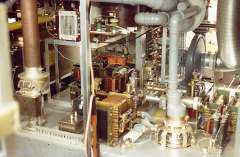
(click picture to enlarge)
We made a conscious decision to go for very high-tech pulse-duration modulation transmitters
On my return from leave in 1980 it was time to get down to work on Radio Botswana's awful shortwave reception. Don finally retired gracefully to his shop and we welcomed an expatriate Scot, Kinnear MacDonald, as his replacement. Kinnear had previously run the BBC's Far-Eastern relay station. His great experience and knowledge made up for what I lacked.
(click picture to enlarge)
Sebele transmitting station staff (and a driver!) in the early 1980's. As well as head of transmitters Kinnear MacDonald (extreme right), Emmanuel "Scott" Tabane and "Tiger" Nkwe, anyone familiar with Radio Botswana today may be amused to identify "States" Batsalelwang and Habuji "Sos" Sosome. Unfortunately I don't have an equivalent picture of the studio staff.